A View from the Atlantic Sobey Art Award - Art Gallery of Nova Scotia
A View from the Atlantic Sobey Art Award - Art Gallery of Nova Scotia
A View from the Atlantic Sobey Art Award - Art Gallery of Nova Scotia
- No tags were found...
You also want an ePaper? Increase the reach of your titles
YUMPU automatically turns print PDFs into web optimized ePapers that Google loves.
Lorenzen Bowl, 1967, Stoneware, 5.5 x18.5 x 19.0 cm, Gift <strong>of</strong> Barbara Nielson, Halifax, <strong>Nova</strong> <strong>Scotia</strong>, 2004Maria Morrisa <strong>Nova</strong> <strong>Scotia</strong>n Garland10on view untilJanuary 17, 2010Botanical illustration is a specialisedart form demandingboth art and science. The sixtysmall watercolours in a recentlydiscovered album <strong>of</strong> botanicaldrawings by Maria Morris revealher tentative explorations <strong>of</strong> <strong>the</strong>genre. In her later lithographs,published with text by TitusSmith, Alexander Forrester, andGeorge Lawson, she wouldrepresent <strong>the</strong> flowers life-sizedwithout <strong>the</strong> illusory effect <strong>of</strong>cast shadows while maintainingan aes<strong>the</strong>tically pleasing presentationon <strong>the</strong> page. In <strong>the</strong>seearly watercolours <strong>the</strong> plants arereduced to a small format pageand four <strong>of</strong> <strong>the</strong>m cast shadows.Perhaps she was able to accessissues <strong>of</strong> Curtis’s BotanicalMagazine for guidance or perhapsTitus Smith recommendedagainst <strong>the</strong> shadows, when headvised her about botanicalnomenclature.During his survey <strong>of</strong> <strong>the</strong> provincesinterior in 1801 and 1802,Smith had prepared a listing <strong>of</strong><strong>the</strong> flowers and trees he found.Smith’s fa<strong>the</strong>r, a Yale graduatewho had tutored him inma<strong>the</strong>matics, <strong>the</strong>ology, botany,chemistry, medicine, and languages,may have broughtPhilip Miller’s The Gardener’sDictionary with him when <strong>the</strong>family came to <strong>Nova</strong> <strong>Scotia</strong> asSandemanian Loyalists in 1783.About 1790, John Wentworthgave <strong>the</strong>m a complete set <strong>the</strong>Species Plantarum <strong>of</strong> Linnaeus.In <strong>the</strong> 1830s <strong>the</strong>re was littleo<strong>the</strong>r counsel for Maria Morris in<strong>Nova</strong> <strong>Scotia</strong>. Torrey’s and Eaton’srecently published studies maynot have been available. AsaGray’s Manual <strong>of</strong> <strong>the</strong> Botany <strong>of</strong><strong>the</strong> Nor<strong>the</strong>rn American Stateswould not appear until 1847.The Flora Boreali-Americana<strong>of</strong> 1803, based on AndreMichaux’s botanical survey <strong>of</strong>North America between 1785and 1796 with illustrations byPierre-Joseph Redouté, includedQuebec, but not <strong>the</strong> Maritimes,and William Jackson Hooker’stwo, very expensive, volumeswith <strong>the</strong> same title, which didinclude <strong>Nova</strong> <strong>Scotia</strong>n examplescollected by Lady Dalhousie,would not appear until 1840.Cronquist, Thorne, and <strong>the</strong>Angiosperm Phylogeny Groupwere all far in <strong>the</strong> future! Sincebotanical nomenclature haschanged considerably in recenttime, Marian Munro, Curator <strong>of</strong>Botany for <strong>the</strong> <strong>Nova</strong> <strong>Scotia</strong> Museum,has provided <strong>the</strong> modernnames for each <strong>of</strong> <strong>the</strong> flowersrepresented.Morris probably studied flowerpainting with JE Acres in Halifaxin 1826; <strong>the</strong>se lessons, plus <strong>the</strong>recent publication <strong>of</strong> Doro<strong>the</strong>aDix’s The Garland <strong>of</strong> Flora, mayhave inspired Morris to approachTitus Smith about herproject to illustrate <strong>the</strong> flora <strong>of</strong><strong>Nova</strong> <strong>Scotia</strong>. By 1840 when Morriswas publishing her first set <strong>of</strong>lithographs, Dix had discovered<strong>the</strong> poor conditions suffered by<strong>the</strong> insane in Boston and, for <strong>the</strong>remainder <strong>of</strong> her life, devotedherself to <strong>the</strong> establishment <strong>of</strong>humane hospitals. This sharedconcern led her to work withHugh Bell <strong>of</strong> Halifax toward<strong>the</strong> building <strong>of</strong> Mount HopeAsylum in Dartmouth, wheretending gardens was part <strong>of</strong> <strong>the</strong>treatment. Morris’s lithographs,in turn, inspired Clotilda Jenningsto write a series <strong>of</strong> poemsabout <strong>the</strong> “Wild Flowers <strong>of</strong> <strong>Nova</strong><strong>Scotia</strong>” that were publishedin The Provincial, or HalifaxMonthly Magazine, publishedby Mary Jane Katzmann, whoalso included an article on <strong>the</strong>well-being <strong>of</strong> <strong>the</strong> mentally-ill inone <strong>of</strong> her last issues. Jenningslater moved to Montreal whereshe continued to write. In 1866,Katzmann, now running <strong>the</strong>Provincial Bookstore, wouldpublish <strong>the</strong> third set <strong>of</strong> MariaMorris Miller’s lithographs.The 1830s were a period <strong>of</strong>intellectual awakening in <strong>Nova</strong><strong>Scotia</strong>. The watercolours andrelated later lithographs inthis exhibition provide a pathinto that period when JosephHowe’s public letters in <strong>the</strong><strong>Nova</strong>scotian exhorted his fellowcitizens to acquaint <strong>the</strong>mselveswith o<strong>the</strong>r areas <strong>of</strong> <strong>the</strong> province,<strong>the</strong> Mechanics’ Institute <strong>of</strong>feredlectures on a broad spectrum <strong>of</strong>literary, philosophical, historical,geographical, and scientificissues, and <strong>the</strong> arts and lettersthrived.Dr. Dianne O’Neill,Associate Curator, HistoricalPrints and Drawingson view untilDecember 13, 2009Maritime Modern showcasesexamples <strong>of</strong> 1950s and 1960scontemporary ceramics <strong>from</strong><strong>the</strong> <strong>Art</strong> <strong>Gallery</strong> <strong>of</strong> <strong>Nova</strong> <strong>Scotia</strong>’spermanent collection. Theexhibition features work bythree famous Canadian ceramiccouples: Krystyna Sadowskaand Konrad Sadowski, Erica andKjeld Deichmann, and Ernstand Alma Lorenzen. FollowingWorld War II <strong>the</strong> Maritimes experiencedan influx <strong>of</strong> talentedcraftspeople trained at some<strong>of</strong> Europe’s top art schools.When <strong>the</strong>y arrived in Canada<strong>the</strong>y brought with <strong>the</strong>m a newaes<strong>the</strong>tic sensibility based onEuropean modernism with itsstreamlined shapes, symbolicdesigns, and elegant forms.Mary E. Black, who was hiredin 1943 to organize a provincialhandicrafts program for<strong>the</strong> <strong>Nova</strong> <strong>Scotia</strong> Department<strong>of</strong> Industry and Publicity,recognized <strong>the</strong> importance <strong>of</strong><strong>the</strong>se European influencesand encouraged <strong>the</strong> newlyfounded Handicraft Centre toteach modern pottery. This isan important point, as Blackhas sometimes been malignedfor entrenching <strong>Nova</strong> <strong>Scotia</strong>’scrafts within an idealized folktradition. However, her encouragement<strong>of</strong> <strong>the</strong> innovativework <strong>of</strong> artists like KrystynaSadowska indicates that Blackwas certainly supportive <strong>of</strong>modernist aes<strong>the</strong>tics. In 1951Black praised Sadowska’s craftsmanshipand original designs,writing that <strong>Nova</strong> <strong>Scotia</strong>nsshould study Sadowska’s “striking”work. She went on to creditSadowska with bringing to <strong>the</strong>province “…techniques anddesigns hi<strong>the</strong>rto unused.”In 1935 <strong>the</strong> first couple toestablish <strong>the</strong>mselves in <strong>the</strong>Maritimes (and it could be saidin Canada) as contemporarystudio ceramists were KjeldDeichmann who emigrated<strong>from</strong> Denmark, and his wifeErica. The National Film Boardfilmed <strong>the</strong>ir country pottery onseveral occasions and contributedto its becoming a populartourist destination in NewBrunswick. Although small, <strong>the</strong>two Deichmann dishes shownin this exhibition, with simplebut elegant forms, and minimaldecoration encapsulate <strong>the</strong>Scandinavian modern style sopopular in Canada during <strong>the</strong>1950s and 1960s.Krystyna Sadowska and herhusband Konrad Sadowskistudied with Norah Billington at<strong>the</strong> Central School <strong>of</strong> <strong>Art</strong>s andCrafts in London, England. In1949 <strong>the</strong>y moved to Halifax toteach at <strong>the</strong> Handcraft Centreafter seeing a Polish travel bookentitled Pine-Scented Canada.Their work achieved considerableacclaim. The tablewareshown in this exhibition featuresfanciful maritime imageryand was made at <strong>the</strong> Sadowskis’Indian Harbour studio, which<strong>the</strong>y kept as a summer retreatafter <strong>the</strong>y moved to Toronto in1953.Ernst and Alma Lorenzen werepioneers in <strong>Nova</strong> <strong>Scotia</strong> studiopottery, although <strong>the</strong>y opened<strong>the</strong>ir first pottery studio in 1946in New Brunswick. The Lorenzenshave a deep connectionto <strong>the</strong> Shaw Ceramic <strong>Gallery</strong>,as it was Lloyd Shaw, <strong>the</strong> wellknownowner <strong>of</strong> <strong>the</strong> brickworksin Lantz, <strong>Nova</strong> <strong>Scotia</strong>, who readabout <strong>the</strong> Lorenzens in a newspaperarticle and invited <strong>the</strong>mto move near his Lantz factory,where he built <strong>the</strong>m a houseand adjoining studio with aninterest-free mortgage. Ernst’sskill with wheel work, whichhe gained while studying inhis native Denmark, and Alma’swith sculpting, modelling, andsurface decoration allowed<strong>the</strong>m to create a range <strong>of</strong> functionalobjects <strong>from</strong> bowls tomushrooms used as study toolsby mycologists. The Lorenzensdeveloped <strong>the</strong>ir own array <strong>of</strong>glazes using local minerals andwere dedicated to using <strong>Nova</strong><strong>Scotia</strong> clay.Each <strong>of</strong> <strong>the</strong> couples in <strong>the</strong>exhibition contributed greatlyto <strong>the</strong> craft community <strong>of</strong> <strong>the</strong>Maritimes, and helped establishthis region as a leader incontemporary ceramics.Dr. Sandra Alfoldy,Associate Curator <strong>of</strong> Fine CraftART GALLERY OF NOVA SCOTIA FALL JOURNAL 2009 ART GALLERY OF NOVA SCOTIA FALL JOURNAL 2009 11



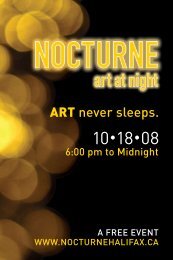
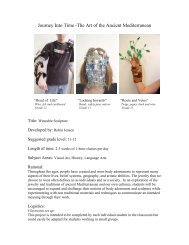
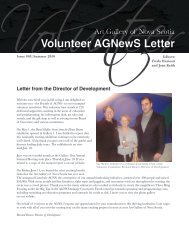

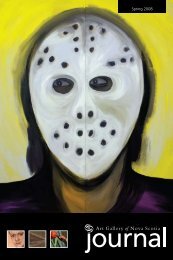

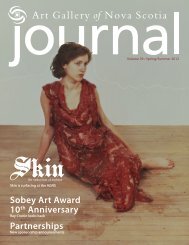
![Elizabeth Bishop - Crazy Quilts and Stories [pdf] - Art Gallery of Nova ...](https://img.yumpu.com/43102277/1/190x245/elizabeth-bishop-crazy-quilts-and-stories-pdf-art-gallery-of-nova-.jpg?quality=85)
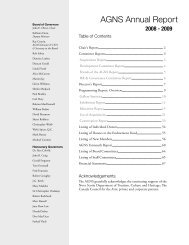
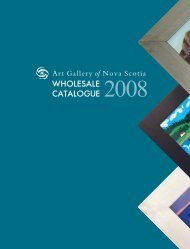

![Senior High lesson plan brochure [pdf] - Art Gallery of Nova Scotia](https://img.yumpu.com/36529943/1/190x146/senior-high-lesson-plan-brochure-pdf-art-gallery-of-nova-scotia.jpg?quality=85)

![Junior High lesson plan brochure [pdf] - Art Gallery of Nova Scotia](https://img.yumpu.com/35457408/1/190x146/junior-high-lesson-plan-brochure-pdf-art-gallery-of-nova-scotia.jpg?quality=85)